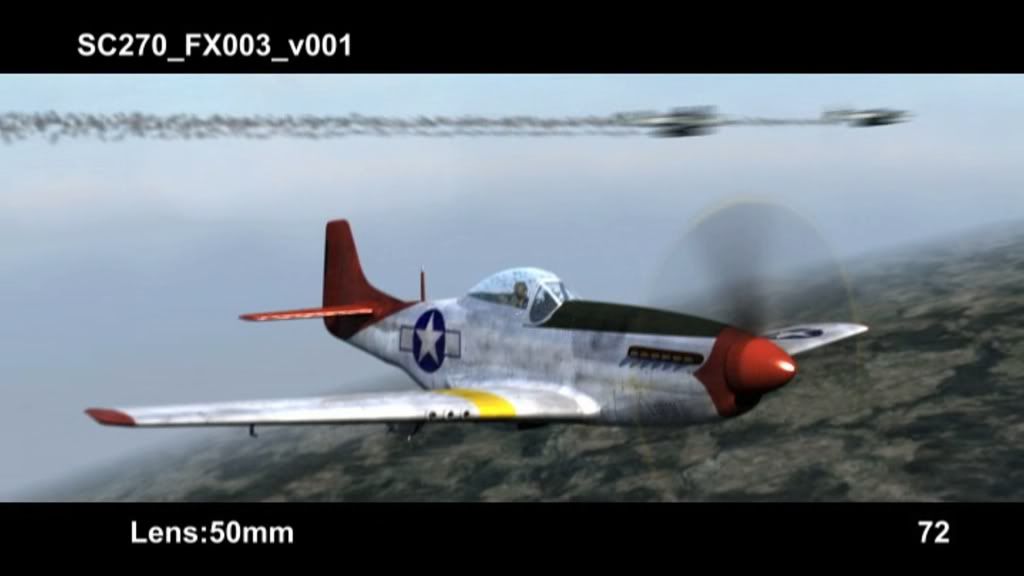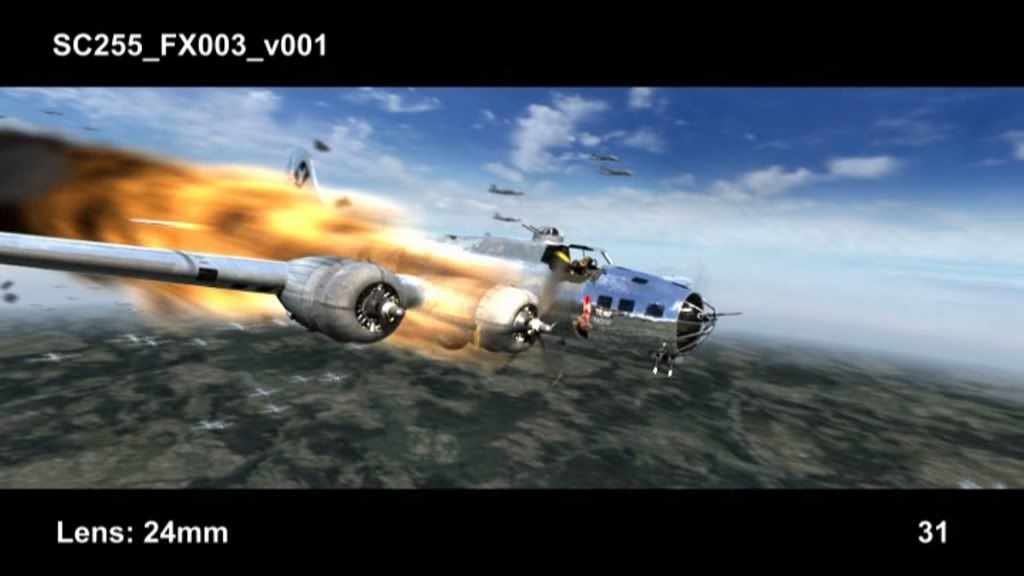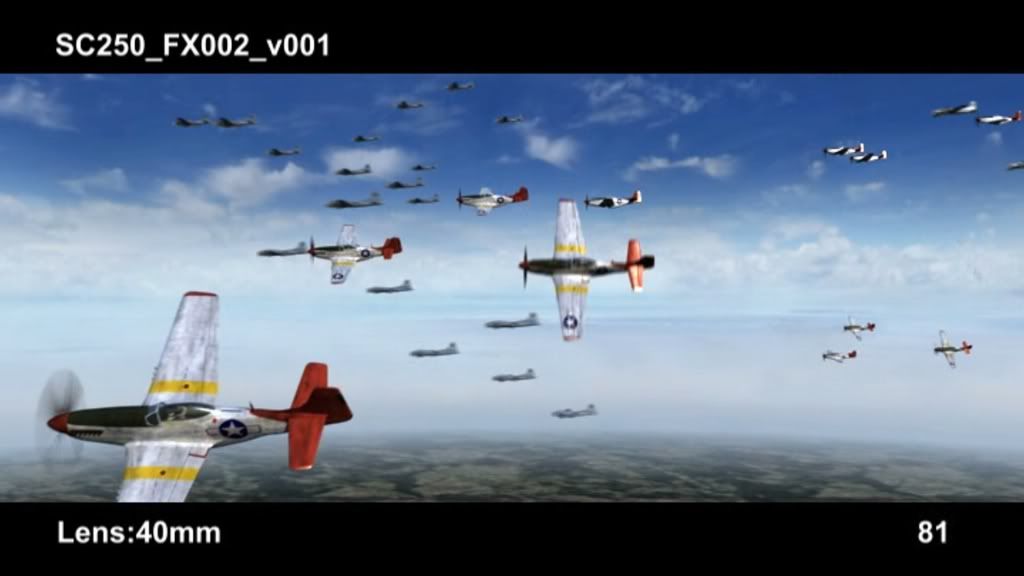Radical 3D pre-visualization artists tap the power of LightWave 3D to deliver impressive aerial combat motion and scene files for Red Tails, the latest film from George Lucas
The first African-American military aviators to serve in the U.S. armed forces endured and overcame adversity, including racial segregation and discrimination, during World War II to fight in defense of freedom. Despite others’ attempts at denying them their own freedoms, the Tuskegee Airmen risk life and limb to help bring an end to what was to become the deadliest conflict in human history. These trailblazers trained and flew with distinction, achieved success in virtually all their missions, aided in the Allies in victory, and, nearly 70 years later, continue to win accolades.
In 2007, President George W. Bush awarded roughly 300 Tuskegee Airmen the Congressional Gold Medal. In 2008, a portion of Route 6 outside Atlanta was renamed in honor of the Tuskegee Airmen. In 2009, more than 120 Tuskegee Airmen accepted President-Elect Barack Obama’s invitation to attend the inauguration of the first African-American President of the United States. In 2012, New York’s Metropolitan Transportation Authority Regional Bus Operations renamed its 100th Street depot to the Tuskegee Airmen Depot. The same year, renown filmmaker George Lucas debuted Red Tails, a tribute to the Tuskegee Airmen nearly a quarter of a century in the making.
Unique Undertaking
Production of Red Tails proved to be as unique as its subject—a heroic group of black U.S. Army Air Force (USAAF) servicemen who painted the tails of their aircraft red and became known as "Red Tails." Like the airmen, the film had a precarious start, but a strong and lasting finish.
Lucas first envisioned the film as a narrative in 1988 but, 24 years later, ended up releasing one of the first action films with an all-black cast. It is a fictional portrayal based on a wealth of historical recounts, from surviving Tuskegee Airmen and the pilots’ mission logbooks from the 1940s. The film is replete with impressive aerial feats and combat maneuvers, all reproduced digitally but based on factual combat events.
Just as WWII united powerful militaries from around the globe, Red Tails brought together some of the best talents and brightest minds in the business worldwide. Various remote studios contributed computer graphics imagery (CGI) and visual effects (VFX), while one firm— Radical 3D in Venice, California—handled all the pre-visualization (previs).
Mike Blanchard, head of post-production at Lucasfilm who works closely with Producer Rick McCallum and Lucas, was creating the video storyboard for the film with the help of "Dog Fights," a series that Jason McKinley, owner of Radical 3D, a high-end computer graphics (CG) animation company specializing in television and movie special effects, created and directed for The History Channel. McKinley’s work on the series won him an invitation to Skywalker Ranch and to "take a run at the opening sequence" of the film, he says.
company specializing in television and movie special effects, created and directed for The History Channel. McKinley’s work on the series won him an invitation to Skywalker Ranch and to "take a run at the opening sequence" of the film, he says.
"We pre-vised 100 to 130 shots using [NewTek’s] LightWave 3D, and they were really happy with it," recalls McKinley, pre-vis supervisor and technical consultant on Red Tails. They were so pleased, in fact, that they asked McKinley and the Radical 3D team to previs the last 600 shots of the film, the climactic end sequence with flight dynamics, planes, and aerial combat. "Originally, it was going to be 300 shots, but they kept expanding it and said ‘keep going.’"
McKinley oversaw pre-vis of all the shots, as well as a staff that averaged six artists but extended to 10 at times, with modelers and others working on the project. "You can do a lot more with a small crew with LightWave than you can with any other software package," he affirms. "You have a great pool of generalists and it enables you to do things on a budget better than the other software packages that I’ve dealt with. LightWave helps us get the job done for the tight budgets that are out there these days."
Filming took place over five months in 2009 in the Czech Republic, Italy, Croatia, and England. Pre-vis spanned roughly six weeks for the opening sequence, and 12 weeks for the closing sequence. McKinley credits his software tool of choice with helping speed production.
"LightWave is the fastest software out there, period," McKinley mentions. "There are a lot of very good software packages out there, but they all take longer to do things. Nothing can touch LightWave." McKinley and his team were able to streamline their work flow further by taking advantage of the assets and experience gained while working on "Dog Fights."
"We have one of the largest CGI libraries of military airplanes in the world," McKinley describes. "We already had a lot of those assets built and we also had seen almost every air combat maneuver. I interviewed more than 100 pilots, almost all of them aces. We had really strong insight into the kinds of maneuvers they used."
Maximizing Motion
LightWave has been McKinley’s tool of choice since he started his career in 1992. "It has always been my tool and it has done really well for me," he says. "You can get great looks out of every software out there if you have great people, but for speed and getting a good look, LightWave is untouchable.
"It helped me sell ‘Dog Fights,’ helped us produce Armageddon, and helped us really well on Red Tails, especially with the motion tools that are good for flying things around. In fact, it made my career on flying things around; LightWave has done really well for me."
McKinley and the Radical 3D artists relied on LightWave’s Graph Editor, a Virtual Studio tool introduced in version 10 that enables hand-editing of live-captured and virtual performances, for Red Tails. "The ease of the motion graph editor was really strong for us," he explains. "We used it a lot; it just makes flying things around very easy."
"LightWave is easily the fastest, get-a-good-look-as-fast-as-you-can software out there--without a doubt. There’s no muss, no fuss," McKinley says. "Everything is built in: You get your modeler, great animation, and a great renderer--all in the same box, ready to go."
Outside the Box
The Radical 3D team produced roughly five different models and three separate environments for the project. "It was all pre-vis, but it was nice looking; it wasn’t cheesy," McKinley describes. "I think it helped [the other studios’ CG and VFX artists] realize a lot more with pre-vis looking better than what they were used to."
Radical 3D artists worked remotely with the client, Lucasfilm, sending them a series of QuickTime files every day. They also handed off their pre-vis work to Industrial Light & Magic (ILM), a division of Lucasfilm.
"ILM took all the pre-vis we had, all our scene files and motion files from LightWave, with zero issues," McKinley says. "They used a lot of those motion files in the final animation—that was gratifying. There are shots in the film that are literally exactly the same as our pre-vis—nothing changed, not even a camera. Then you can see ones where they changed the camera a little bit, but it’s the same airplane motion. And then there are others that are a composite or hybrid of a couple shots we did."
Significant Sequences
McKinley and his team are especially proud that two sequences comprising "the big money shot of the entire film" came from Radical 3D. Originally, the film’s final shot was one gigantic, climactic battle.
"The Red Tails escorted the B-17s during a massive propeller-driven, BF-109 attack. They fight them off, and then one of the planes gets hit. They stay with it, and then jets attack; they fight those guys off and one of the heroes is killed. It was a massive, 600-shot sequence," McKinley recalls. "In the final film, they split it into two separate sequences: an escort mission where they were attacked by the regular BF-109s and the last sequence, where they were attacked by the jets and defending the lone B-17."
In one sequence, "one of the Tuskeegee Airmen is on the tail of a German ace, who does an insane, high-speed, tall rotating maneuver where he actually spins the plane a full 360 degrees in mid-air and shoots the Tuskeegee Airmen as he flies by," McKinley describes. "Later on in the film, one of the Tuskeegee Airmen does the same maneuver and shoots a plane down—and that was the money shot used to promote the entire film. Every trailer ended with that shot--that was gratifying to see."
It was a real aerial combat maneuver that Pilot Richard Candelaria, member of the 435th Fighter Squadron, 479th Fighter Group, described to McKinley during his research for "Dog Fights." Candelaria performed the maneuver in WWII while being chased by a BF-109G German fighter that he could not shake. "In a last ditch effort, he pulled this stunt," McKinley says. "It was such an iconic move; the fact that it was real is even better. Matt Zeyn and Tom Bremmer did a great job with it. We used LightWave for that shot."
The move wasn’t in the storyboard or the story, but Radical 3D artists put in the pre-vis. "They were so happy with it that it became a story point," McKinley notes. "We are really proud of that one, specifically." It is rare, but gratifying when impressive graphics influence the storyline.
Looking back, McKinley and his team of artists at Radical 3D continue to be impressed with Red Tails. "Just the sheer scale of the project… The film has 60 minutes of 100 percent CGI with 1,600 effects shots. It’s a massive-scale project, and it takes someone like Lucasfilm to do it."
Producer McCallum is equally thrilled with Red Tails and its impressive effects, all of which started in pre-vis. He also credits the pre-vis process with helping not only save money, but also better focus the director, who might not have experience working with VFX. "Without previsualization, we couldn’t have done anything," he says. "With someone like [McKinley] doing pre-vis and a company like Halo doing animatics, it changes everything—the whole dynamics."
Red Tails IMDb stats: www.imdb.com/title/tt0485985/
About LightWave
NewTek LightWave 3D® combines a state-of-the-art renderer with powerful, intuitive modeling and animation tools. LightWave 10 is designed to support the creative process, providing the artist with the ability to interact in real time with 3D content, to work seamlessly with the full range of software applications in production pipelines and to render on unlimited render nodes. LightWave is enjoyed worldwide, as a complete 3D production solution for visual effects in film, television, broadcast graphics, print, games, visualization, and the Web, and is responsible for more artists winning Emmy® Awards than any other 3D application.
About NewTek
Benefiting producers and artists with cost-effective and groundbreaking technologies, NewTek is a worldwide leader in 3D animation and special effects tools, portable live production and video editing including LightWave 3D®, the TriCaster™ product line and 3Play™. NewTek has won numerous industry accolades, including two Emmy® Awards. NewTek products have been used in feature films and television shows, including "Avatar," "TinTin," "Repo Men," "V," "Fringe," "CSI: Crime Scene Investigation," "The Fairly OddParents" and more.
NewTek is privately owned and based in San Antonio. For more information, please visit: www.newtek.com.